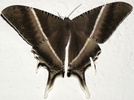Geometroidea



This tree diagram shows the relationships between several groups of organisms.
The root of the current tree connects the organisms featured in this tree to their containing group and the rest of the Tree of Life. The basal branching point in the tree represents the ancestor of the other groups in the tree. This ancestor diversified over time into several descendent subgroups, which are represented as internal nodes and terminal taxa to the right.

You can click on the root to travel down the Tree of Life all the way to the root of all Life, and you can click on the names of descendent subgroups to travel up the Tree of Life all the way to individual species.
For more information on ToL tree formatting, please see Interpreting the Tree or Classification. To learn more about phylogenetic trees, please visit our Phylogenetic Biology pages.
close boxReferences
Abraham, D., N. Ryrholm, H. Wittzell, J. D. Holloway, M. J. Scoble, and C. Lofstedt. 2001. Molecular phylogeny of the subfamilies in Geometridae (Geometroidea: Lepidoptera). Molecular Phylogenetics and Evolution 20(1):65-77.
Cook, M. A., and M. J. Scoble. 1992. Tympanal organs of geometrid moths: a review of their morphology, function, and systematic importance. Systematic Entomology 17(3):219-232.
Minet, J. and M. J. Scoble. 1999. The drepanoid/geometroid assemblage. Pages 301-320 in: Lepidoptera: Moths and Butterflies. 1. Evolution, Systematics, and Biogeography. Handbook of Zoology Vol. IV, Part 35. N. P. Kristensen, ed. De Gruyter, Berlin and New York.
Pitkin, L. M. 1996. Neotropical Emerald moths: A review of the genera (Lepidoptera: Geometridae, Geometrinae). Zoological Journal of the Linnean Society 118(4):309-440.
Title Illustrations

| Scientific Name | Lyssa zampa |
|---|---|
| Location | outside the NUS Raffles Museum of Biodivsersity Research, Singapore |
| Creator | Photo by Kelvin Lim |
| Specimen Condition | Live Specimen |
| Source | 11lyssa_zampa-rmbr20may2005edit[klim] |
| Source Collection | Flickr |
| Image Use |
 This media file is licensed under the Creative Commons Attribution-NonCommercial-ShareAlike License - Version 2.0. This media file is licensed under the Creative Commons Attribution-NonCommercial-ShareAlike License - Version 2.0.
|
| Copyright | © 2005 Otterman |
| Scientific Name | Epione repandaria |
|---|---|
| Location | Castel d’Aiano, Bologna Province, Emilia Romagna, Italy |
| Specimen Condition | Live Specimen |
| Image Use |
 This media file is licensed under the Creative Commons Attribution-NonCommercial License - Version 2.0. This media file is licensed under the Creative Commons Attribution-NonCommercial License - Version 2.0.
|
| Copyright |
© 2005 Cesare Brizio

|
About This Page
Page copyright © 2010
 Page: Tree of Life
Geometroidea.
The TEXT of this page is licensed under the
Creative Commons Attribution-NonCommercial License - Version 3.0. Note that images and other media
featured on this page are each governed by their own license, and they may or may not be available
for reuse. Click on an image or a media link to access the media data window, which provides the
relevant licensing information. For the general terms and conditions of ToL material reuse and
redistribution, please see the Tree of Life Copyright
Policies.
Page: Tree of Life
Geometroidea.
The TEXT of this page is licensed under the
Creative Commons Attribution-NonCommercial License - Version 3.0. Note that images and other media
featured on this page are each governed by their own license, and they may or may not be available
for reuse. Click on an image or a media link to access the media data window, which provides the
relevant licensing information. For the general terms and conditions of ToL material reuse and
redistribution, please see the Tree of Life Copyright
Policies.
Citing this page:
Tree of Life Web Project. 2003. Geometroidea. Version 01 January 2003 (temporary). http://tolweb.org/Geometroidea/12031/2003.01.01 in The Tree of Life Web Project, http://tolweb.org/









 Go to quick links
Go to quick search
Go to navigation for this section of the ToL site
Go to detailed links for the ToL site
Go to quick links
Go to quick search
Go to navigation for this section of the ToL site
Go to detailed links for the ToL site